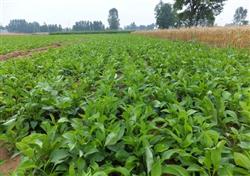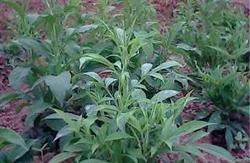It is important to protect seedlings in order to achieve high yield of atractylodes macrocephala

As a kind of traditional Chinese medicine with high economic value, Atractylodes macrocephala Koidz is planted by more and more people. However, due to the uneven level of planting and management, the economic benefits of growers vary greatly. Especially for the first time, the growth habits of Atractylodes macrocephala Koidz and the prevention and control of diseases and insect pests are not sure, which often results in a large number of dead seedlings in the early stage of Atractylodes macrocephala Koidz, and the benefit is low, and some even lose money. Through several years of planting, my greatest experience is that if you want to have a high yield of Atractylodes macrocephala Koidz, it is most important to protect seedlings in the early stage. First, promote the strong seedling to find ways to promote the seedling of Atractylodes macrocephala Koidz to be strong, which can greatly improve the disease resistance of Atractylodes macrocephala Koidz. The first is reasonable middle ploughing, which must be carried out twice after the seedlings of Atractylodes macrocephala Koidz are produced, and the principle of "deep first hoe and shallow second hoe" should be grasped in order to reduce the field humidity, increase the soil permeability and promote the root system to go down. The second is to spray foliar fertilizer, if the seedlings of Atractylodes macrocephala are thin and weak, you can spray 15kg of water on 15ml of Bioujia plus 25g of potassium dihydrogen phosphate in the whole field. If the leaves of the seedlings are small and yellowing, you can use 15kg of water to spray 10g of Ruipele plus 5g of zinc in the whole field. Second, because Atractylodes macrocephala Koidz is resistant to drought and afraid of waterlogging, watering should be controlled as far as possible, especially at the seedling stage, not watering until it is a last resort, but at the same time, 200ml of Ruimiaoqing per mu plus 1.5 kg of Wukuying should be applied to prevent seedling diseases. Third, the control of diseases and insect pests caused the seedling death of Atractylodes macrocephala Koidz at seedling stage. There are three major diseases, namely, blight, root rot and quenching disease, among which Rhizoctonia solani is the most serious and harmful. Rhizoctonia solani, also known as "rotten stem plague", is more serious in overcast and rainy days, and the base of the damaged seedling is dark brown, and then it shrinks and sinks, causing the seedlings to collapse and die. Root rot occurs in the roots, and the main roots rot, resulting in the death of seedlings. Sudden fall disease and blight disease occurred at the same site, both at the base of the stem, lodging quickly after the disease, but normal in the upper part. Watering should be controlled first in prevention and control. The smaller the humidity in the field is, the lighter the disease is. In the early stage of the disease, Rhizoctonia solani and root rot were sprayed with 8 ml of Rimiaoqing plus 20 grams of microorganism. The cataplexy disease was sprayed with 15 kg of water and 20ml of water to prevent the disease. It should be noted that when spraying, the liquid should flow to the root and stem of Atractylodes macrocephala Koidz. The main pests of Atractylodes macrocephala are aphids, Liriomyza huidobrensis and ground tiger. Aphids and planthoppers were controlled with golden years, and Liriomyza huidobrensis was killed with avermectin. Control tigers can be sprayed around the roots of Atractylodes macrocephala before evening.
- Prev

Planting technique of traditional Chinese Medicine Atractylodes macrocephala Koidz
Cultivation techniques 1. Seedling (1) A month before sowing, Atractylodes macrocephala Koidz turned over the soil, covered with weeds 30 cm thick, burned the soil and disinfected it to prevent diseases and insect pests. After burning, turn the grass ash into the soil. If the soil is not burned, it can be turned over in the winter of the first year so that the soil can be fully weathered by freezing. Land.
- Next

Pollution-free cultivation techniques of Atractylodes macrocephala Koidz
Atractylodes macrocephala Koidz is wild distributed in Zhejiang, Jiangxi, Hunan, Hubei and Shaanxi, and can be planted in these provinces and North China. The porous, loose and fertile sandy loam is beneficial to the root growth of Atractylodes macrocephala Koidz, which is suitable for planting Atractylodes macrocephala Koidz.
Related
- Fuxing push coffee new agricultural production and marketing class: lack of small-scale processing plants
- Jujube rice field leisure farm deep ploughing Yilan for five years to create a space for organic food and play
- Nongyu Farm-A trial of organic papaya for brave women with advanced technology
- Four points for attention in the prevention and control of diseases and insect pests of edible fungi
- How to add nutrient solution to Edible Fungi
- Is there any good way to control edible fungus mites?
- Open Inoculation Technology of Edible Fungi
- Is there any clever way to use fertilizer for edible fungus in winter?
- What agents are used to kill the pathogens of edible fungi in the mushroom shed?
- Rapid drying of Edible Fungi

